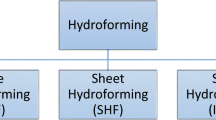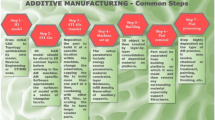Abstract
Several machining processes have been created and improved in order to achieve the best results ever accomplished in hard and difficult to machine materials. Some of these abrasive manufacturing processes emerging on the science frontier can be defined as ultra-precision grinding. For finishing flat surfaces, researchers have been putting together the main advantages of traditional abrasive processes such as face grinding with constant pressure, fixed abrasives for two-body removal mechanism, total contact of the part with the tool, and lapping kinematics as well as some specific operations to keep grinding wheel sharpness and form. In the present work, both U d-lap grinding process and its machine tool were studied aiming nanometric finishing on flat metallic surfaces. Such hypothesis was investigated on AISI 420 stainless steel workpieces U d-lap ground with different values of overlap factor on dressing (U d = 1, 3, and 5) and grit sizes of conventional grinding wheels (silicon carbide (SiC) = #800, #600, and #300) applying a new machine tool especially designed and built for such finishing. The best results, obtained after 10 min of machining, were average surface roughness (Ra) of 1.92 nm, 1.19-μm flatness deviation of 25.4-mm-diameter workpieces, and mirrored surface finishing. Given the surface quality achieved, the U d-lap grinding process can be included among the ultra-precision abrasive processes and, depending on the application, the chaining steps of grinding, lapping, and polishing can be replaced by the proposed abrasive process.
Similar content being viewed by others
References
Saljé E, Paulmann R. (1988) Relations between abrasive process. In: CIRP, 37.,1988. Annals of the CIRP, p.641-648
Stähli AW (1998) The technique of lapping.Pieterlen: Technical Editorial of TheA.W. STÄHLI
Sanchez LEA, Xu Jun NZ, Fiocchi AA (2011) Surface finishing of flat pieceswhen submitted to lapping kinematics on abrasive disc dressed under several overlap factors. Precis Eng 35(2):355–363
Fiocchi AA (2010) Avanços no desenvolvimento de um processo de acabamento para peças planas submetidas à cinemática de lapidação sobre um rebolo dressado com grau de recobrimento. 143 f. Dissertação (Mestrado) – Faculdade de Engenharia de Bauru, Universidade Estadual Paulista, Bauru, 2010
Brinksmeier E, Mutlugünes Y, Klocke F, Aurich LC, Shore P, Ohmori H (2010) Ultra-precision grinding. In: CIRP, 59, 2010. Annals of the CIRP - Manufacturing Technology.v.59, p.652-671
Fiocchi AA, Sanchez LEA, Oliveira JFG, Marinescu ID (2011) Investigation on surface finishing of components ground withlapping kinematics: lapgrinding process. 13th CIRP Conference on Modeling of Machining Operations (CIRP CMMO,) Annals of the CIRP
Emaranhes ID, Hitchiner M, Uhlmann E, Rowe WR, Inasaki I (2007) Handbook of machining with grinding wheels. CRC Press, Wakefield
Marinescu ID, Rowe WB, Dimitrov B, Inasaki I (2004) Tribology of abrasive machining processes, 1st edn. William Andrew Publishing, New York
Ohmori H, Marinescu ID, Katahira K (2011) Electrolytic In-ProcessDressing (ELID) Technologies: Fundamentals and Applications.1.ed. CRC Press
Touge M, Matsuo T (1996) Removal rate and surface roughness in high-precisionlapping of Mn-Zn ferrite. In: CIRP, 45, 1996. Annals of the CIRP.p.307-310
Gatzen HH, Maetzig JC (1997) Nanogrinding. Precis Eng 21:134–139
Gatzen HH, Maetzig JC, Schwabe M (1996) Precision machining of rigid diskhead sliders. IEEE Trans Magn 32(3):1843–1849
Tomita Y, Eda H (1996) A study of the ultra precision grinding process on a magneticdisk substrate – development of new bonding materials for fixed abrasives of grinding stone. Wear 195:74–80
Beyer P, Ravenzwaaij M (2005) Innovative flat honing with vitrified-bond grindingand conditioning tools.Industrial Diamond Review IDR, n.4, p.47-50
Wegener K, Hoffmeister HW, Karpuschewski B, Kuster F, Hahmann WC, Rabiey M (2011) Conditioning and monitoring of grinding wheels. In: CIRP,60, 2011. Annals of the CIRP - Manufacturing Technology.p.757–777
Kloch F (2015) Preparing grinding wheels for use. Manufacturing Technology I. Laboratory for Machine Tools and Production Engineering. FraunhoferInstitutProduktionstechnologie, Aachen
Oliveira JFG, Purquerio BM, Coelho RT, Bianchi EC (1992) Grinding process dominance by means of the dressing operation. In: Proceedings of the 29th International Matador Conference. p.547-560
König W, Messer J (1980) Dressing conventional grinding wheels with polycrystallinediamond (in German). Industrie-Anzeiger 4(102):35–38
Filho NM, Coelho RT, Oliveira JFG (1999) Analysis of dressing performance using single crystal diamond dressers.Industrial Diamond review,n.2
Pahl G, Beitz W, Feldhusen J, Grote KH (2007) Engineering Design – A systematic Approach. Springer.3rdEdition
Author information
Authors and Affiliations
Corresponding author
Rights and permissions
About this article
Cite this article
Fiocchi, A.A., Fortulan, C.A. & de Angelo Sanchez, L.E. Ultra-precision face grinding with constant pressure, lapping kinematics, and SiC grinding wheels dressed with overlap factor. Int J Adv Manuf Technol 79, 1531–1543 (2015). https://doi.org/10.1007/s00170-015-6933-5
Received:
Accepted:
Published:
Issue Date:
DOI: https://doi.org/10.1007/s00170-015-6933-5




